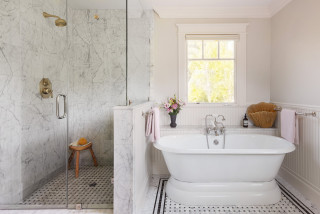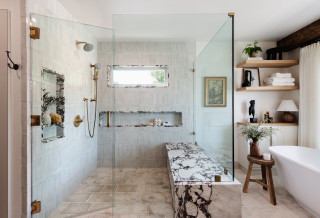
This article was originally published by a www.houzz.com . Read the Original article here. .

This article was originally published by a www.houzz.com . Read the Original article here. .

In fact, for the squeegee-averse, opting to use the guest bathroom and its shower with a curtain instead of a glass door is a timesaving trick that is not uncommon. Friends of mine once admitted that they shower in their guest bathroom so they don’t have to clean their newly remodeled, all-glass master bath shower. There’s got to be a better way. And I think there is.
This article was originally published by a www.houzz.com . Read the Original article here. .

2. Adapting to Change
Bathroom at a Glance
Who lives here: A couple and their toddler daughter
Location: London, Ontario
Size: 73 square feet (6.8 square meters)
Design-build firm: Ben + Britt at Home
Before: With a toddler who has a potentially mobility-affecting condition, these Canadian homeowners brought on Brittany Zazula and Ben Davis to adapt the whole house, including this bath, for wheelchair use.
Davis and Zazula are a husband-and-wife design-build team who used Houzz Pro software for this project. While functionality came first in the redesign, they also wanted to give the family a soothing and bright space.
This article was originally published by a www.houzz.com . Read the Original article here. .

29. Polished chrome or polished nickel. “These days, most of my clients ask me to specify finishes that are not too trendy, so either a polished chrome or polished nickel with a PDV or similar finish is my go-to,” Brock says. “Gold and matte brass are on-trend right now and they are beautiful, but I’m not sure how long they will be around, so I use them sparingly.”
When it comes to fashionable shower finishes, Palicki advises saving “the trends for things that are easier and less expensive to change, such as light fixtures, hardware and faucets.”
This article was originally published by a www.houzz.com . Read the Original article here. .

“I like to do things in horizontal layers, like a cake,” she says. “For example, here the cabinet hardware [aged brass] is one layer, the plumbing fixtures [polished nickel] are the next layer, and the mirrors and sconces [unlacquered brass] are the next layer. I will also stick with the same finish in categories, such as all the plumbing fixtures or lighting fixtures. Also, I’ll use all warm or all cold finishes within one room. Polished nickel can go either way, but it has warm undertones that chrome does not.”
This article was originally published by a www.houzz.com . Read the Original article here. .

The same tiles used for the backsplash wrap the upper portion of the walls. Below ¾-inch step molding are 12-by-24-inch Mystery White marble tiles. “The Mystery White happens to be really well-priced and has some warmth running through it,” Brien says. “That warmth coordinates with the warmth you see in the Taj Mahal.”
The pale beige hexagonal stone floor tile continues seamlessly into the shower. “The walls are neutral, so I wanted to mix up the textures and materials to add more interest and depth,” Brien says.
New to home remodeling? Learn the basics
This article was originally published by a www.houzz.com . Read the Original article here. .

While keeping plumbing in the same spots is often cited as a way to keep costs down, Nightingale cautions that function and layout should always be the top priorities. “If you need to save, save on the finishes, because those are easy to fix or replace later. Not having a good layout is not something you can surmount cost-effectively,” he says.
Plus, moving all the plumbing versus leaving it as is might not be as expensive as you think, Nightingale says. For his company, $1,000 to $1,500 is typical. “On top of that, now you also have brand-new shutoff valves and you have new drains,” he says. “And you can get a lot of extra benefits besides just increasing function and making it more aesthetically pleasing. You also now have the peace of mind that you just put all this money and finishes into a bathroom and it’s going to last.”
This article was originally published by a www.houzz.com . Read the Original article here. .
Where would you like your shower to stand? A corner is the most common spot, but the center of a room or a separate enclosed area like a water closet might be best for your layout or lifestyle.
Keep in mind that moving or adding plumbing costs money, sometimes a lot of money. So if that’s not in your budget, try to keep your updated shower in the same location as your previous one.
If you’re wondering how much space you’ll need, consider that the most popular shower widths are 32, 36 and 60 inches. (Lengths will vary.) Shower dimensions can be as small as 32 by 32 inches, but most people prefer a shower that’s at least 36 by 48 inches. Shower ceiling heights typically fall between 84 and 120 inches, depending on the space and the design.
You’ll also want to consider the dimensions of other elements in your bathroom before deciding on your shower size. For example, the size of your planned vanity might require a reduced shower space, so you might want to consider going for a smaller vanity to get a larger shower.
Another thing to consider is increasing the size of your bathroom to get the shower size you want. Talk with your design pro about opportunities to steal space from an adjacent closet or bedroom or even whether relocating the bathroom to another room in the house is the best move.
Find a bathroom designer near you